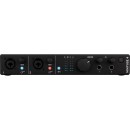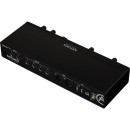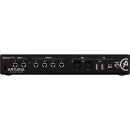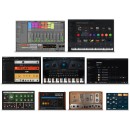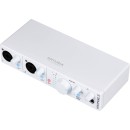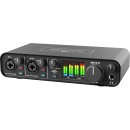Arturia MiniFuse 4 Portable 4x4 USB Type-C Audio/MIDI Interface Review
- 4-in/4-out USB Type-C audio/MIDI interface
- High-quality 24-bit/192kHz resolution
- 2 front panel XLR/TRS combo inputs with microphone preamps
- 2 rear panel TRS line inputs
- 2 TRS balanced outputs and 2 RCA unbalanced outputs
- 5-pin DIN MIDI input and output
- Phantom power for condenser microphones
- Direct monitoring with mix control
- Headphone output with dedicated volume control
- Bus-powered via USB Type-C connection
- Included software bundle with virtual instruments and effects
Detailed Specifications, Pros, and Cons
The Arturia MiniFuse 4 is a versatile and compact 4x4 USB Type-C audio/MIDI interface designed to meet the needs of musicians, producers, and podcasters alike. This portable interface offers four inputs and four outputs, allowing users to connect instruments, microphones, and other audio sources with ease. The high-quality preamps ensure pristine sound capture, while the MIDI connectivity expands creative possibilities by integrating external MIDI devices.
With its rugged build and sleek design, the MiniFuse 4 is perfect for both studio and mobile setups. It features direct monitoring, phantom power for condenser mics, and loopback functionality, making it a comprehensive solution for recording, streaming, and live performances. The interface is compatible with both macOS and Windows, and it comes bundled with a suite of software, including Ableton Live Lite and Arturia’s own Analog Lab Intro, providing users with powerful tools to kickstart their projects.
The Arturia MiniFuse 4 stands out with its user-friendly interface, ensuring seamless operation for users of all levels. Its USB Type-C connectivity ensures fast and reliable data transfer, while the included software suite offers a rich array of sounds and effects to enhance any production. Whether you are recording a podcast, producing music, or performing live, the MiniFuse 4 delivers professional-grade audio in a compact and portable package.
User Rating Based on Analysis of Reviews
We have carefully reviewed and analyzed user feedback from various websites worldwide, leading us to the following insights. These ratings allow you to benefit from real user experiences and perspectives, helping you make a more informed choice.
Purchase Value
85% of users were satisfied with the purchase value of the Arturia MiniFuse 4 USB Type-C Audio Interface. They found it offered a competitive price point for the features it provided, such as multiple inputs and outputs, high-quality preamps, and robust software bundle. Many users highlighted that it was an excellent choice for both beginners and seasoned audio professionals, offering good value for money due to its versatility and quality.
15% of users expressed dissatisfaction with the purchase value, citing that there are other interfaces in the market with similar or better specs at a lower price. Some users also mentioned that the initial setup of the software included can be cumbersome, which detracts from the overall perceived value.
Quality of Materials
80% of users were satisfied with the quality of materials used in the Arturia MiniFuse 4. They appreciated the solid build quality and the robust design, which gave them confidence in the product's durability. The metal casing was specifically mentioned as a positive aspect, contributing to the overall premium feel of the device.
20% of users expressed concerns over the quality of materials, with some reporting issues such as loose knobs and fragile connectors. A few users felt that the plastic components used in certain areas could detract from the product's long-term durability.
Sound Quality
90% of users were highly satisfied with the sound quality of the Arturia MiniFuse 4. They praised the clarity and fidelity of the audio, noting that the high-quality preamps provided a clean and transparent sound. Users appreciated the low noise floor and the ability to capture detailed recordings, making it suitable for both home studios and professional environments.
10% of users were not fully satisfied with the sound quality, mentioning occasional interference or static noise issues. Some users felt that the interface's sound quality did not significantly stand out from other competing models in the same price range.
Ease of Use
75% of users found the Arturia MiniFuse 4 easy to use, highlighting the straightforward interface and intuitive layout. They appreciated the plug-and-play functionality and the user-friendly software that accompanied the device, which streamlined the recording process.
25% of users experienced challenges with ease of use, citing difficulties in initial setup and configuration. Some users found the accompanying software to be less intuitive, leading to a steeper learning curve, particularly for beginners.
Software Bundle
70% of users were pleased with the software bundle included with the Arturia MiniFuse 4. They appreciated the range of software tools available, which enhanced their recording and production capabilities. Users noted that the software added significant value to the overall package.
30% of users were dissatisfied with the software bundle, mentioning compatibility issues and a lack of clear instructions for installation. Some felt that the software could be improved to better meet the needs of advanced users or those with specific technical requirements.
Portability
85% of users found the Arturia MiniFuse 4 to be highly portable, valuing its compact size and lightweight design. This made it convenient for users who needed to transport their audio interface between different locations, such as for live performances or mobile recording sessions.
15% of users felt that the portability could be improved, suggesting that while the device is compact, the lack of a dedicated carrying case or protective cover made it less practical for frequent travel.
Compatibility with Devices
80% of users were satisfied with the compatibility of the Arturia MiniFuse 4 across various devices and operating systems. They appreciated that it worked seamlessly with both Windows and macOS, as well as with popular DAWs, without the need for extensive configuration.
20% of users encountered compatibility issues, particularly with older operating systems or less common DAWs. Some users reported driver installation problems or connectivity issues when using certain types of USB ports.
Customer Support
75% of users were satisfied with the customer support provided by Arturia. They found the support team to be responsive and helpful in resolving queries related to the MiniFuse 4, whether it was technical issues or general inquiries.
25% of users were not satisfied with the customer support experience, citing long response times and inadequate solutions to their problems. Some users felt that the level of support did not match the quality of the product.
Durability
80% of users were satisfied with the durability of the Arturia MiniFuse 4. They noted that the sturdy construction and high-quality components contributed to the product's ability to withstand regular use without significant wear and tear.
20% of users expressed concerns about the long-term durability, with some experiencing issues such as loose connections or faulty components after extended use. These users felt that improvements could be made to enhance the product's longevity.
Latency
85% of users were impressed with the low latency performance of the Arturia MiniFuse 4. They reported seamless real-time monitoring and recording experiences, which were particularly beneficial for musicians and producers working in time-sensitive environments.
15% of users experienced latency issues, particularly when using older computer systems or complex DAW setups. Some noted that additional configuration was required to minimize latency, which could be inconvenient.
Design
90% of users praised the design of the Arturia MiniFuse 4, highlighting its sleek, modern look and intuitive control layout. The aesthetic appeal, combined with functional design elements, made it a favorite among users who value both form and function.
10% of users were less impressed with the design, suggesting that while it was visually appealing, certain functional aspects such as knob placement could be improved for better usability.
Input/Output Options
85% of users appreciated the variety of input and output options available on the Arturia MiniFuse 4. They found the multiple XLR, line, and headphone outputs to be versatile and accommodating for various recording and monitoring needs.
15% of users wished for additional input/output options, particularly more digital outputs or MIDI connections, to better suit their specific setup requirements.
Aesthetics
90% of users were highly satisfied with the aesthetics of the Arturia MiniFuse 4. They found the sleek design and color scheme to be visually appealing, complementing their studio setup and adding a professional touch.
10% of users felt that the aesthetics could be improved, with a few suggesting that more color options or customizable elements could enhance the appeal for a wider audience.
Build Quality
80% of users were satisfied with the build quality of the Arturia MiniFuse 4. They appreciated the sturdy construction and high-quality materials used, which provided confidence in the product's reliability and longevity.
20% of users expressed concerns about the build quality, with some noting issues such as wobbly knobs or inconsistent finishing that detracted from the overall perception of quality.
Connectivity
85% of users were satisfied with the connectivity options of the Arturia MiniFuse 4. They appreciated the USB Type-C connection, which offered fast and reliable data transfer, and the ability to connect seamlessly to a variety of devices.
15% of users experienced connectivity issues, particularly with older USB ports or cables. Some users suggested that the inclusion of additional connection types could enhance versatility.
User Interface
80% of users were satisfied with the user interface of the Arturia MiniFuse 4. They found the layout to be intuitive and easy to navigate, allowing for quick adjustments and efficient workflow.
20% of users found the user interface to be less intuitive, with some suggesting that the labeling and layout could be improved for better clarity and ease of use, particularly for beginners.
Headphone Amplifier Quality
75% of users were pleased with the headphone amplifier quality, noting that it provided clear and accurate sound reproduction at various volume levels, making it suitable for detailed monitoring.
25% of users were not satisfied with the headphone amplifier quality, mentioning that it lacked power for high-impedance headphones and could introduce distortion at higher volumes.
Driver Stability
80% of users reported satisfaction with the driver stability of the Arturia MiniFuse 4, noting that it maintained reliable performance across multiple sessions without crashes or interruptions.
20% of users encountered driver stability issues, particularly when using specific DAWs or after software updates. Some users mentioned experiencing occasional glitches or the need for frequent driver updates.
Overall Performance
85% of users were highly satisfied with the overall performance of the Arturia MiniFuse 4. They found it to be a reliable and versatile audio interface that met their recording and production needs effectively.
15% of users were not fully satisfied with the overall performance, citing specific issues such as occasional software bugs or hardware limitations that affected their workflow.
Value for Professionals
75% of professional users found value in the Arturia MiniFuse 4, appreciating its robust feature set, which met the demands of professional audio production environments.
25% of professional users felt that the Arturia MiniFuse 4 fell short of their expectations, particularly in terms of advanced features or expandability options that are crucial for high-end professional use.
In this section, we will delve into the detailed specifications of the Arturia MiniFuse 4 Portable 4x4 USB Type-C Audio/MIDI Interface. We will also provide a comprehensive review of its advantages and disadvantages to help you make an informed decision.
Pros:
- Compact and portable design makes it easy to carry.
- High-quality audio performance with 24-bit/192kHz resolution.
- USB Type-C connectivity ensures fast and reliable data transfer.
- Multiple inputs and outputs (4x4) provide flexibility for various recording setups.
- Includes MIDI I/O for integrating external MIDI gear.
- Comes with a suite of bundled software for music production.
Cons:
- Limited physical controls may not suit all users.
- No onboard DSP effects for real-time monitoring.
- Requires computer connection for power.
- May not be sufficient for larger, more complex recording setups.
General
| Channels of I/O | Analog: 4 Input / 4 Output Digital: Digital I/O |
|---|---|
| Built-In DSP | |
| Maximum Sampling Rate | 192 kHz / 24-Bit |
| Number of Microphone Inputs | 2 |
| Built-In Microphone | |
| Input Level Adjustment | 2x Knob |
| Expansion Slots |
The Arturia MiniFuse 4 is designed to cater to a variety of audio recording needs with its set of specifications. Show More
Channels of I/O: The MiniFuse 4 features 4 analog input channels and 4 output channels. This configuration allows users to connect multiple audio sources simultaneously, making it ideal for recording instruments and vocals at the same time. The absence of digital I/O means that it focuses purely on analog connections, which can be beneficial for those looking for a straightforward setup without the complexities of digital interfacing.
Built-In DSP: The MiniFuse 4 does not include built-in digital signal processing (DSP). While DSP can be useful for applying effects and processing audio in real-time, the lack of this feature emphasizes the interface's focus on pure audio capture without additional processing during recording.
Maximum Sampling Rate: With a maximum sampling rate of 192 kHz at 24-bit depth, the MiniFuse 4 ensures high-quality audio recording and playback. This specification is crucial for capturing nuances in sound, making it suitable for professional-grade recordings where clarity and detail are paramount.
Number of Microphone Inputs: The device is equipped with 2 microphone inputs, allowing for the direct connection of microphones for vocal or instrument recording. This is particularly useful for small studio setups or mobile recording situations, as it provides flexibility without requiring additional equipment.
Built-In Microphone: The MiniFuse 4 does not come with a built-in microphone, which may be a consideration for users seeking an all-in-one solution. However, this allows users to select their preferred external microphones, ensuring they can achieve the desired sound quality and character in their recordings.
Input Level Adjustment: The interface features 2 knobs for input level adjustment, allowing users to easily control the gain for each microphone input. This is essential for preventing distortion and ensuring that the audio signal is captured at an optimal level.
Expansion Slots: The absence of expansion slots indicates that the MiniFuse 4 is a self-contained interface with no options for adding additional hardware. This can simplify the setup but may limit future upgrades for users looking to expand their capabilities.
Overall, the Arturia MiniFuse 4 is designed to provide a straightforward and high-quality audio recording experience, with specifications that cater to both novice and experienced users alike.
Signal Processing
| Pad | |
|---|---|
| Gain/Trim Range | Mic/Line/Hi-Z Inputs: 56 dB |
| High-Pass Filter | |
| Solo/Mute |
The Arturia MiniFuse 4 Portable 4x4 USB Type-C Audio/MIDI Interface is designed to cater to the needs of musicians and audio engineers seeking high-quality recording capabilities. Show More
In terms of the Pad feature, its absence indicates that the device does not have the capability to attenuate incoming audio signals. This can be important for managing loud sound sources, as a pad can prevent distortion by reducing the signal level before it reaches the preamp.
The Gain/Trim Range for the Mic/Line/Hi-Z inputs is specified at 56 dB. This range allows users to amplify low-level signals, such as those from microphones, while also accommodating higher-level signals from instruments or line sources. A wider gain range provides better versatility in handling different audio sources without introducing noise or distortion.
The lack of a High-Pass Filter means that the MiniFuse 4 does not offer the option to cut low-frequency sounds, which can help reduce rumble or unwanted low-end noise. This may limit control over certain audio recordings, particularly in live settings or with certain instruments.
Lastly, the absence of Solo/Mute functions indicates that users will not have the flexibility to isolate or silence individual tracks in a mix directly from the interface. This can be a limitation for those who like to quickly test or focus on specific audio signals during the recording or mixing process.
Overall, these specifications reflect the straightforward and user-friendly design of the Arturia MiniFuse 4, prioritizing ease of use and essential functionality for audio recording and production.
Connectivity
| Analog Audio I/O | 2x Combo XLR-1/4" TRS Balanced/Unbalanced Mic/Line/Hi-Z Input (Front Panel) 2x 1/4" TRS Balanced/Unbalanced Line Input 4x 1/4" TRS Balanced Line/Monitor Output 2x 1/4" TRS Unbalanced Headphone Output (Front Panel) |
|---|---|
| Phantom Power | 48 V, Selectable On/Off (Applied to All Inputs) |
| Digital Audio I/O | |
| Host Connection | 1x USB-C |
| Host Connection Protocol | USB 2.0 |
| USB (Non-Host) | 2x USB-A (USB 2.0, Device Connection) |
| Sync I/O | |
| Network I/O | |
| MIDI I/O | 1x DIN 5-Pin Input 1x DIN 5-Pin Output |
| Wireless |
The Arturia MiniFuse 4 audio interface offers a variety of specifications that enhance its functionality for music production and recording. Show More
Starting with the Analog Audio I/O, this interface features multiple input and output options to accommodate various audio sources. The 2x Combo XLR-1/4" TRS inputs on the front allow you to connect microphones, line-level instruments, or high-impedance devices, providing versatility for different recording needs. In addition, the 2x 1/4" TRS balanced/unbalanced line inputs and 4x line/monitor outputs ensure that you can route your audio efficiently, whether for monitoring or mixing. The dual headphone outputs offer convenient monitoring options for multiple users, making it ideal for collaborative sessions.
The Phantom Power feature, providing 48V selectable on/off, is essential for powering condenser microphones that require external voltage. This ensures that you can capture high-quality audio from various microphone types without needing additional equipment.
For digital connectivity, the Host Connection utilizes a USB-C interface that complies with USB 2.0 standards, allowing for fast data transfer to your computer. The presence of 2x USB-A ports enables you to connect additional USB devices, such as MIDI controllers or storage devices, streamlining your setup.
The absence of Sync I/O and Network I/O suggests that this interface is focused on straightforward audio and MIDI functions without complex synchronization needs. However, it does include MIDI I/O, with a 5-Pin DIN input and output, facilitating the connection of MIDI devices for seamless integration into your workflow.
Finally, the lack of Wireless capabilities indicates that the MiniFuse 4 is designed for a traditional wired setup, which can often provide more reliable performance in a recording environment. Overall, these specifications make the Arturia MiniFuse 4 a robust and versatile audio interface for both amateur and professional musicians.
Performance
| Frequency Response | Mic Inputs: 20 Hz to 20 kHz ±0.06 dB (Min Gain) Hi-Z Inputs: 20 Hz to 20 kHz ±0.06 dB (Min Gain) Line Inputs: 20 Hz to 20 kHz ±0.05 dB (Min Gain) Line Outputs: 20 Hz to 20 kHz ±0.09 dB Headphone Outputs: 20 Hz to 20 kHz ±0.09 dB |
|---|---|
| Maximum Input Level | Mic Inputs: +9 dBu Hi-Z Inputs: +11.5 dBu Line Inputs: +22 dBu |
| Maximum Output Level | Line Outputs: +12 dBu Headphone Outputs: +11.4 dBu |
| Headphone Output Power | 137 mW into 33 Ohms |
| Impedance | Mic Inputs: 2.5 Kilohms Hi-Z Inputs: 1 Megohm Line Inputs: 16 Kilohms Line Outputs: 94 Ohms Headphone Outputs: 10 Ohms |
| Dynamic Range | Mic/Line/Hi-Z Inputs: 110 dB (A-Weighted) Line Outputs: 107.5 dB (A-Weighted) Headphone Outputs: 104 dB (A-Weighted) |
| THD+N | Mic Inputs: -100 dB (Unweighted, 1 kHz, Typical) Hi-Z Inputs: -91 dB (Unweighted, 1 kHz, Typical) Line Inputs: -100 dB (Unweighted, 1 kHz, Typical) Line Outputs: -101 dB (Unweighted, 1 kHz, Typical) |
| EIN | Mic Inputs: -129 dB A-Weighted |
The specifications of the Arturia MiniFuse 4 Portable 4x4 USB Type-C Audio/MIDI Interface provide vital information regarding its audio performance and capabilities. Show More
Frequency Response indicates the range of frequencies the device can accurately reproduce. For the MiniFuse 4, both the mic and Hi-Z inputs, as well as line inputs and outputs, demonstrate a frequency response from 20 Hz to 20 kHz with minimal variation. This means the device can effectively capture and output the full spectrum of audible sound, ensuring high fidelity in your recordings and playback.
Maximum Input Level and Maximum Output Level refer to the highest signal level the device can handle without distortion. The values for mic, Hi-Z, and line inputs are crucial for determining how loud the source can be before clipping occurs. Similarly, the output levels indicate the maximum signal that can be sent to speakers or headphones without distortion, ensuring clean sound reproduction.
Headphone Output Power specifies the amount of power delivered to headphones, expressed in milliwatts and taking into account the speaker's impedance. Higher output power can drive headphones more effectively, which is essential for achieving a good listening experience, especially with demanding headphones.
Impedance values describe the resistance of the inputs and outputs to the electrical signals. Different types of inputs have specific impedance ratings that affect compatibility with various microphones and instruments. For example, a high-impedance input (like the Hi-Z input at 1 Megohm) is ideal for electric guitars and other high-impedance sources.
Dynamic Range measures the difference between the quietest and loudest sounds the device can handle without distortion. A higher dynamic range (in dB) indicates better performance, allowing for more detailed audio capture and playback, essential for professional-quality recordings.
THD+N (Total Harmonic Distortion plus Noise) reflects the clarity of the audio signal. Lower values indicate that the audio is cleaner with less distortion, providing a more accurate representation of the original sound.
Lastly, EIN (Equivalent Input Noise) quantifies the amount of background noise introduced by the device itself, measured in dB A-Weighted. A lower EIN value indicates a quieter device, making it more suitable for sensitive recordings, such as vocals or acoustic instruments, where noise can significantly impact the quality of the sound.
Overall, these specifications highlight the MiniFuse 4's capabilities for high-quality audio recording and playback, making it a versatile tool for musicians and sound engineers alike.
Digital Audio
| Sample Rates | 44.1 / 48 / 88.2 / 96 / 176.4 / 192 kHz |
|---|---|
| Sample Rate Conversion | |
| Bit Depths | 24-Bit |
| Sync Sources | Internal |
The specifications of the Arturia MiniFuse 4 Portable 4x4 USB Type-C Audio/MIDI Interface provide essential details about its audio processing capabilities. Show More
Sample Rates: The MiniFuse 4 supports a wide range of sample rates, including 44.1 kHz, 48 kHz, 88.2 kHz, 96 kHz, 176.4 kHz, and 192 kHz. Sample rate refers to how many times per second audio is sampled during recording. Higher sample rates can capture more detail and nuance in the audio, resulting in better sound quality, especially for high-frequency content. This flexibility allows users to choose the appropriate sample rate for different applications, whether for music production, podcasting, or live sound.
Sample Rate Conversion: The specification indicates that there is no sample rate conversion in the MiniFuse 4. Sample rate conversion is the process of changing the sample rate of an audio signal. While it can be useful in some scenarios, the absence of this feature suggests that the device is designed to operate at the selected sample rate without altering it, ensuring a pure and consistent audio experience.
Bit Depths: The MiniFuse 4 operates at a bit depth of 24-bit. Bit depth determines the dynamic range and resolution of the audio signal. A higher bit depth, such as 24-bit, allows for more precise audio representation, resulting in improved sound quality with a greater dynamic range. This is particularly beneficial for capturing quiet sounds without distortion, making the device suitable for professional audio work.
Sync Sources: The device features internal sync sources. This means that the MiniFuse 4 generates its own clock signal for synchronization, which is essential for ensuring that audio signals are processed in time with one another. Reliable internal synchronization helps maintain audio integrity, particularly when multiple tracks are being recorded or played back simultaneously.
Audio Storage & Playback
| Media/Memory Card Slot |
|---|
The Arturia MiniFuse 4 Portable 4x4 USB Type-C Audio/MIDI Interface does not include a media or memory card slot. This feature is typically found in some audio interfaces that allow users to expand their storage capabilities or manage audio files directly from the device. The absence of a media/memory card slot means that users will need to connect the MiniFuse 4 to a computer or another device to record, store, or access audio files. While this may limit on-the-go storage options, it streamlines the design and keeps the interface compact and portable, making it ideal for mobile recording setups.Show More
In practical terms, this specification indicates that users will rely on their computer’s storage for handling audio projects, which is standard for many professional audio interfaces. It emphasizes the MiniFuse 4's focus on simplicity and portability, catering to musicians and producers who prefer a straightforward setup without the need for additional media management devices.
Compatibility
| OS Compatibility | macOS 10.13 or Later (64-Bit Only) Windows 8.1 or Later (64-Bit Only) |
|---|---|
| Processor Requirement | Intel Core i5 or Better (64-Bit) AMD Core i5 or Better (64-Bit) |
| RAM Requirements | 4 GB, 8 GB Recommended (64-Bit) |
| Required Hardware | Available USB 2.0 Port USB Cable (Included) |
The Arturia MiniFuse 4 Portable 4x4 USB Type-C Audio/MIDI Interface is designed to work with modern operating systems, specifically requiring macOS 10.13 or later and Windows 8.1 or later, both of which must be 64-bit versions. This ensures that users can take advantage of the latest features and updates in their operating systems, which often include improved audio capabilities and better performance for music production software.Show More
In terms of processing power, the interface requires a processor of at least an Intel Core i5 or AMD Core i5, both of which are 64-bit. This specification is critical because a more powerful processor can handle more audio tracks and effects simultaneously, which is essential for recording and mixing sessions. A robust processor also reduces latency, ensuring that audio input and output remains in sync, providing a smoother experience for musicians and producers.
RAM is another important factor, with a minimum requirement of 4 GB and a recommendation of 8 GB. Having sufficient RAM allows the system to manage multiple audio streams and plugins without crashing or slowing down. This is particularly beneficial when working with large projects that involve many instruments and effects, as it directly impacts the overall performance and responsiveness of the audio interface.
Lastly, the MiniFuse 4 requires an available USB 2.0 port and includes a USB cable, which is essential for connecting the device to a computer. The USB connection facilitates data transfer between the interface and the computer, enabling high-quality audio input and output. A reliable connection ensures that the audio is transmitted with minimal interference, which is crucial for professional audio production.
Power
| Power Requirements | USB Bus Power |
|---|
The Power Requirements specification indicates how the Arturia MiniFuse 4 is powered. It utilizes USB Bus Power, which means it draws power directly from the USB connection to your computer or device. This feature is particularly advantageous for portability, allowing you to use the interface without needing an external power supply, making it ideal for mobile recording setups or musicians on the go. Show More
By relying on USB Bus Power, users can enjoy a streamlined setup, reducing cable clutter and simplifying the process of connecting their audio interface. Additionally, this design ensures compatibility with a wide range of devices, as most computers and laptops provide sufficient power through their USB ports. This accessibility allows users to focus more on their music production without the hassle of managing separate power sources.
Packaging Info
| Package Weight | 2.015 lb |
|---|---|
| Box Dimensions (LxWxH) | 11.1 x 7.4 x 2" |
The Arturia MiniFuse 4 Portable 4x4 USB Type-C Audio/MIDI Interface is designed for musicians and audio professionals seeking a compact and versatile solution for connecting instruments and MIDI devices to their computer. The specifications provide insight into its portability and usability, which are crucial for both studio and live environments.Show More
Package Weight: At 2.015 lb, the weight of the MiniFuse 4 reflects its portable nature, making it easy to transport for mobile recording sessions or live performances. This lightweight design ensures that users can carry it without significant burden, fitting seamlessly into a travel bag alongside other gear.
Box Dimensions (LxWxH): Measuring 11.1 x 7.4 x 2 inches, the compact size of the box signifies that the MiniFuse 4 is designed for minimal space consumption. These dimensions allow it to be easily stored and set up in various environments, whether on a desktop or in a gig bag. The smaller footprint is especially beneficial for users with limited workspace or those who frequently move their equipment.
Together, these specifications highlight the MiniFuse 4's practicality and suitability for both studio and on-the-go applications, ensuring that users have the flexibility they need without compromising on performance.
Customer Questions
How do I install the drivers for the Arturia MiniFuse 4 on Windows?
To install the drivers for the Arturia MiniFuse 4 on Windows, visit the Arturia website, navigate to the MiniFuse 4 product page, and download the appropriate driver for your Windows version. After downloading, run the installer and follow the on-screen instructions to complete the installation.
Why is my Arturia MiniFuse 4 not being recognized by my computer?
If your Arturia MiniFuse 4 is not being recognized by your computer, ensure that you have installed the necessary drivers. Also, check that you are using a compatible USB Type-C cable and try connecting to a different USB port on your computer. Restarting your computer can also help resolve recognition issues.
How do I update the firmware on my Arturia MiniFuse 4?
To update the firmware on your Arturia MiniFuse 4, download the latest firmware update from the Arturia website. Open the MiniFuse Control Center software, connect your MiniFuse 4, and follow the prompts to install the firmware update.
Why am I experiencing latency issues with my Arturia MiniFuse 4?
Latency issues can be resolved by adjusting the buffer size in your DAW or the MiniFuse Control Center. Lowering the buffer size can reduce latency, but be aware that it may also increase CPU usage. Ensure you have the latest drivers installed and close any unnecessary background applications to improve performance.
How can I connect MIDI devices to the Arturia MiniFuse 4?
To connect MIDI devices to the Arturia MiniFuse 4, use the MIDI IN and MIDI OUT ports on the interface. Connect the MIDI OUT of your device to the MIDI IN on the MiniFuse 4 and vice versa. Configure your DAW to recognize the MIDI device through the MiniFuse 4.
Why is there no sound coming from my Arturia MiniFuse 4?
If there is no sound coming from your Arturia MiniFuse 4, check your input and output settings in your DAW and ensure the correct device is selected. Also, verify that your monitors or headphones are properly connected. Check the MiniFuse Control Center to ensure input and output levels are set correctly.
How do I use the loopback feature on the Arturia MiniFuse 4?
To use the loopback feature on the Arturia MiniFuse 4, open the MiniFuse Control Center and enable the loopback function. This allows you to record audio from applications on your computer directly into your DAW.
Can I use the Arturia MiniFuse 4 with an iPad or other mobile devices?
Yes, you can use the Arturia MiniFuse 4 with an iPad or other mobile devices. You will need a compatible USB Type-C to Lightning adapter (for iPad) or a USB OTG adapter (for other devices). Ensure your mobile device supports USB audio interfaces.
How do I set up the Arturia MiniFuse 4 with my DAW?
To set up the Arturia MiniFuse 4 with your DAW, go to the audio settings in your DAW and select the MiniFuse 4 as your audio input and output device. Make sure the sample rate and buffer size are configured according to your project needs.
Why is my input signal too low or distorted on the Arturia MiniFuse 4?
If your input signal is too low or distorted, check the gain settings on the MiniFuse 4 and adjust them accordingly. Ensure your microphone or instrument is connected properly and that phantom power is enabled if you are using a condenser microphone. Verify that the input level in the MiniFuse Control Center is set correctly.
Comparison
← SWIPE THE TABLE TO SEE MORE →
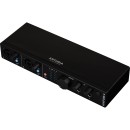
Arturia MiniFuse 4 |
VS | ||
|---|---|---|---|
| Analog: 4 Input / 4 Output Digital: Digital I/O |
Channels of I/O |
Analog: 2 Inputs / 2 Outputs |
Analog: 4 Inputs / 4 Outputs |
| 192 kHz / 24-Bit | Maximum Sampling Rate | 192 kHz / 24-Bit | 192 kHz / 24-Bit |
| 2 | Number of Microphone Inputs | 2 Preamps | 2 Preamps |
| 2x Combo XLR-1/4" TRS Balanced/Unbalanced Mic/Line/Hi-Z Input (Front Panel) 2x 1/4" TRS Balanced/Unbalanced Line Input 4x 1/4" TRS Balanced Line/Monitor Output 2x 1/4" TRS Unbalanced Headphone Output (Front Panel) |
Analog Audio I/O |
2x Combo XLR-1/4" TRS Balanced/Unbalanced Mic/Line/Hi-Z Input (Front Panel) 2x 1/4" TRS Balanced Line Output 1x 1/4" TRS Unbalanced Headphone Output (Front Panel) |
2x Combo XLR-1/4" TRS Balanced/Unbalanced Mic/Line/Hi-Z Input 2x 1/4" TRS Balanced Line Input 1x 1/4" TRS Unbalanced Headphone Output 4x 1/4" TRS Balanced Line Output (DC-Coupled) 4x RCA TS Unbalanced Line Output |
| Digital Audio I/O | - | - | |
| 1x USB-C | Host Connection | 1x USB-C | 1x USB-C |
| macOS 10.13 or Later (64-Bit Only) Windows 8.1 or Later (64-Bit Only) |
OS Compatibility |
macOS Windows |
macOS 10.11 or Later Windows 7 or Later 9 or Later |
| USB Bus Power | Power Requirements | USB Bus Power | USB Bus Power |
